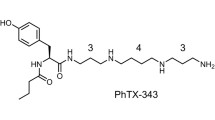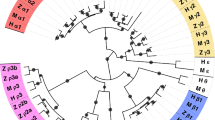Summary
This study examines the subunit requirement for Torpedo acetylcholine receptor (AChR) channel expression and the influence of non-α-subunit deletions on single AChR-channel currents. Xenopus oocytes injected with subunit combinations deficient in single non-α-subunit mRNA transcripts display the following order of ACh sensitivity: β-less > γ-less > δ-less. Oocytes injected with only the α-subunit and one non-α-subunit display the order: αδ > αγ > αβ. These sequences indicate the effectiveness of non-α-subunit substitution is δ > γ > β. Single AChR-channel currents measured in oocytes deficient in either β or γ display conductance and voltage-sensitive burst kinetics similar to the wild-type channel. In contrast, the δ-less combination express channels with burst kinetics that are relatively faster and voltage insensitive. These results indicate that either a specific structural domain in the δ-subunit or its specific interactions with the α-subunit contribute to the voltage-dependent gating of the Torpedo AChR channel.
Similar content being viewed by others
References
Anderson, C.R., Stevens, C.F. 1973. Voltage clamp analysis of acetylcholine produced end-plate current fluctuations at the frog neuromuscular junction. J. Physiol. 235:655–691
Blount, P., Merlie, J.P. 1989. Molecular basis of the two nonequivalent ligand binding sites of the muscle nicotinic acetylcholine receptor. Neuron 3:349–357
Buller, A.L., White, M.M. 1988. Control of Torpedo acetylcholine receptor biosynthesis in Xenopus oocytes. Proc. Natl. Acad. Sci. USA 85:8717–8721
Buller, A.L., White, M.M. 1990. Functional acetylcholine receptors expressed in Xenopus oocytes after injection of Torpedo β, γ, and δ subunit RNAs are a consequence of endogenous oocyte gene expression. Mol. Pharmacol. 37:423–428
Claudio, T. 1989. Molecular genetics of acetylcholine receptorchannels. In: Frontiers in Molecular Biology: Molecular Neurobiology. D.M. Glover, and B.D. Hames, editors. Chap. 3, pp. 63–142. IRL, Oxford
Connolly, J.G. 1989. Structure-function relationships in nicotinic acetylcholine receptors. Comp. Biochem. Physiol. 93A:221–231
De Pamphillis, M.L., Herman, S.A., Martinez-Salas, E., Chalifour, L.E., Wirak, D.O., Cupo, D.Y., Miranda, M. 1988. Microinjecting DNA into mouse ova to study DNA replication and gene expression and to produce transgenic animals. Biotechniques 6:662–665
Dumont, J.N. 1972. Oogenesis in Xenopus laevis (Daudin) 1. Stages of oocyte development in laboratory maintained animals. J. Morphol. 136:153–180
Galzi, J.-L., Revah, F., Bessis, A., Changeux, J.-P. 1991. Functional architecture of the nicotinic acetylcholine receptor: From electric organ to brain. Annu. Rev. Pharmacol. Toxicol. 31:37–72
Golino, M.D., Hamill, O.P. 1991. The δ-subunit determines voltage-dependent closing of Torpedo AChR channels. Soc. Neurosci. 21: 14.2 (Abstr.)
Hamill, O.P., Marty, A., Neher, E., Sakmann, B., Sigworth, F.J. 1981. Improved patch-clamp techniques for high-resolution current recording from cells and cell-free membrane patches. Pfluegers Arch. 391:85–100
Hamill, O.P., Sakmann, B. 1981. Multiple conductance states of single acetylcholine receptor channels in embryonic muscle cells. Nature 294:462–464
Hartman, D.S., Claudio, T. 1990. Coexpression of two distinct muscle acetylcholine receptor α-subunits during development. Nature 343:372–375
Heinemann, S., Boulter, J., Deneris, E., Connolly, J., Gardner, P., Wada, E., Wada, K., Duvoisin, R., Ballivet, M., Swanson, L., Patrick, J. 1989. Brain and muscle nicotinic acetylcholine receptor: A gene family. In: Molecular Biology of Neuroreceptors and Ion Channels. A. Maelicke, editor. NATO ASI Ser H32, pp. 13–30. Springer-Verlag, Berlin
Imoto, K., Busch, C., Sakmann, B., Mishina, M., Konno, T., Nakai, J., Bujo, H., Moro, Y., Fukuda, K., and Numa, S. 1988. Rings of negatively charged amino acids determine the acetylcholine receptor channel conductance. Nature 335:645–648
Jackson, M.B., Imoto, K., Mishina, M., Konno, T., Numa, S., Sakmann, B. 1990. Spontaneous and agonist-induced openings of an acetylcholine receptor channel composed of bovine muscle α-, β- and δ-subunits. Pfluegers Arch. 417:129–135
Kullberg, R., Owens, J.L., Camacho, P., Mandel, G., Brehm, P. 1990. Multiple conductance classes of mouse nicotinic acetylcholine receptors expressed in Xenopus oocytes. Proc. Natl. Acad. Sci. USA 87:2067–2071
Kurosaki, T., Fukada, K., Konno, T., Mori, Y., Tanaki, K.I., Mishina, M., Numa, S. 1987. Functional properties of nicotinic acetylcholine receptor subunits expressed in various combinations. FEBS Lett. 214:253–258
Liu, Y., Camacho, P., Mandel, G., Brehm, P. 1990 Epsilon subunit confers brief channel open time on multiple forms of muscle ACh receptor. Soc. Neurosci. 16:420.2 (Abstr.)
Lo, D.C., Pinkham, J.L., Stevens, C.F. 1990. Influence of the γ subunit and expression system on acetylcholine receptor gating. Neuron 5: 857–866
Lo, D.C., Pinkham, J.L., Stevens, C.F., 1991. Role of a key cysteine residue in the gating of the acetylcholine receptor. Neuron 6:31–40
Lunt, G.G. 1986. Is the insect neuronal nAChR the ancestral ACh receptor protein? Trends Neurosci. 9:341–342
Magleby, K.L., Stevens, C.F. 1972. A quantitative description of endplate currents. J. Physiol. 223:173–197
Methfessel, C., Witzemann, V., Takahashi, T., Mishina, M., Numa, S., Sakmann, B. 1986. Patch clamp measurements on Xenopus laevis oocytes: Currents through endogenous channels and implanted acetylcholine receptor and sodium channels. Pfluegers Arch. 407:577–588
Mishina, M., Takai, T., Imoto, K., Noda, M., Takahashi, T., Numa, S., Methfessel, C., Sakmann, B. 1986. Molecular distinction between fetal and adult forms of muscle acetylcholine receptor. Nature 321:406–411
Noda, M., Takahashi, H., Tanabe, T., Toyosato, M., Kikyotani, S., Furutani, Y., Hirose, T., Takashima, H., Inayama, S., Miyata, T., Numa, S. 1983. Structural homology of Torpedo californica acetylcholine receptor subunits. Nature 302:528–532
Numa, S. 1989. A molecular view of transmitter receptors and ionic channels. Harvey Lect. 83:121–165
Papazian, D.M., Timpe, L.C., Jan, Y.N., Jan, L.Y. 1991. Alteration of voltage-dependence of Shaker potassium channel by mutations in the S4 sequence. Nature 349:305–310
Raftery, M.A., Hunkapiller, M.W., Strader, C.D., Hood, L.E. 1980. Acetylcholine receptor: Complex of homologous subunits. Science 280:1454–1457
Sakmann, B., Methfessel, C., Mishina, M., Tomoyuki, T., Masaaki, K., Fukuda, K., Numa, S. 1985. Role of acetylcholine receptor subunits in gating of the channel. Nature 318:538–543
Sambrook, J., Frisch, E.F., Maniatis, T. 1989. Molecular Cloning: A Laboratory Manual. (2nd ED.) Cold Spring Harbor Lab., Cold Spring Harbor
Sine, S.M., Claudio, T.M., Sigworth, F.J. 1990. Activation of Torpedo AChR expressed in mouse flbroblasts: Single channel current kinetics reveal distinct agonist binding affinities. J. Gen. Physiol. 96: 395–437
Stuehmer, W., Conti, F., Suzuki, H., Wang, X., Noda, M., Yahagi, N., Kubo, H., Numa, S. 1989. Structural parts involved in activation and inactivation of the sodium channel. Nature 339:597–603
Unwin, N., Toyoshiba, C., Kubalek, E. 1988. Arrangement of the acetylcholine receptor subunits in the resting and desensitized states, determined by cryoelectron microscopy of crystallized Torpedo postsynaptic membranes. J. Cell Biol. 107:1123–1138
Yoshii, K., Lei, Y., Mayne, K.M., Davidson, N., Lester, H.A. 1987. Equilibrum properties of mouse-Torpedo acetylcholine receptor hybrids expressed in Xenopus oocytes. J. Gen. Physiol. 90:553–573
Yu, L., Leonard, R.J., Davidson, N., Lester, H.A. 1991. Single-channel properties of mouse-Topedo acetylcholine receptor hybrids expressed in Xenopus oocytes. Mol. Brain Res. 10:203–211
Author information
Authors and Affiliations
Additional information
We thank Dr. Toni Claudio for providing us with the clones and the Cornell Biotechnology Program for their support.
Rights and permissions
About this article
Cite this article
Golino, M.D., Hamill, O.P. Subunit requirements for Torpedo AChR channel expression: A specific role for the δ-subunit in voltage-dependent gating. J. Membarin Biol. 129, 297–309 (1992). https://doi.org/10.1007/BF00232911
Received:
Revised:
Issue Date:
DOI: https://doi.org/10.1007/BF00232911




